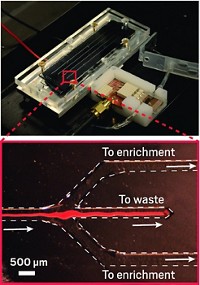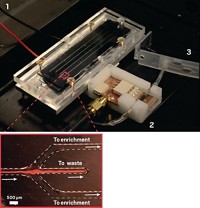Advertisement
Grab your lab coat. Let's get started
Welcome!
Welcome!
Create an account below to get 6 C&EN articles per month, receive newsletters and more - all free.
It seems this is your first time logging in online. Please enter the following information to continue.
As an ACS member you automatically get access to this site. All we need is few more details to create your reading experience.
Not you? Sign in with a different account.
Not you? Sign in with a different account.
ERROR 1
ERROR 1
ERROR 2
ERROR 2
ERROR 2
ERROR 2
ERROR 2
Password and Confirm password must match.
If you have an ACS member number, please enter it here so we can link this account to your membership. (optional)
ERROR 2
ACS values your privacy. By submitting your information, you are gaining access to C&EN and subscribing to our weekly newsletter. We use the information you provide to make your reading experience better, and we will never sell your data to third party members.
Analytical Chemistry
Separating Living Cells From The Dead
Microfluidics: Device uses sound waves to pick out living cells from cultures
by Erika Gebel
November 29, 2012

When researchers test stem-cell or other cell-based therapies, they try to separate living cells from dead ones to increase the chances of the therapy’s success. But removing dead cells from a culture remains a challenge. Now researchers have developed a microfluidic device that uses sound to herd living cells away from the dead (Anal. Chem., DOI: 10.1021/ac3026674).
Scientists often use a specialized type of flow cytometry to sort cells, but this method typically requires labeling living cells with fluorescent antibodies. Such labels “could interfere with cell function,” says Hyongsok Tom Soh of the University of California, Santa Barbara. The antibodies are also expensive, Soh says, increasing the costs when researchers want high-throughput sorting of large numbers of cells.
Soh avoided these pitfalls by sorting using inherent cell properties instead of using labels. He wanted to exploit the fact that almost all mammalian cells get smaller when they die. He thought that sound waves could help with sorting because the waves’ acoustic forces act more strongly on larger objects than on smaller objects.
To capitalize on this power of sound, Soh and his team built a microfluidic device consisting of a channel that splits at one end into three chambers: a central capture chamber and two waste chambers on either side. The researchers placed a piezoelectric transducer under the channel to generate sound waves. Cells enter the channel along its walls and the sound waves jostle them as they travel toward the chambers. This agitation forces the larger, living cells to the middle of the channel, so that at the end of their journey they flow into the capture chamber. Meanwhile, the dead cells remain along the edges and end up in the waste bins.
The researchers tested their sorter with a mixture of living and dead breast tumor cells. In an hour, the device sorted through about 10 million cells. The scientists then determined the number of living and dead cells in the capture chamber using a standard flow cytometry technique. Up to 90% of the cells were alive, which is optimal for stem-cell grafts, according to a study by other researchers (J. Hematotherapy & Stem Cell Res., DOI: 10.1089/152581602321080619). The researchers could maintain this purity up to a flow rate of 12 mL/hour. But at this rate, about 70% of the viable cells entering the channel ended up in the waste bin, compared to 10% at 4 mL/hour.
“The device is very simple and several orders of magnitude less expensive than flow cytometry,” says Rohit Karnik of Massachusetts Institute of Technology. He looks forward to seeing whether cells sorted using this method improve the clinical performance of cell-based therapies. “That would be the proof in the pudding,” Karnik says.





Join the conversation
Contact the reporter
Submit a Letter to the Editor for publication
Engage with us on Twitter